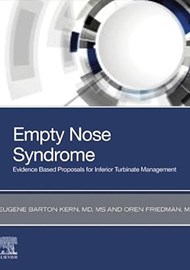To cut or not to cut, that is the question…
The authors of Empty Nose Syndrome emphatically implore the reader to spare the inferior turbinate, lest they cause patients this undue misery! This book is a thought-provoking journey through the phenomenon of empty nose syndrome (ENS), a cautionary tale that most ENT trainees today are warned against when taking their knife (or microdebrider) to the nasal mucosa. The authors comprehensively discuss the contention surrounding management of inferior turbinates throughout history due to the paucity of robust clinical research.
The first chapters begin with a detailed description of ENS with the myriad of presenting symptoms, its association with atrophic rhinitis and potential treatment options. There is an abundance of medical imaging, clinical photographs and diagrams to help illustrate the concepts. There is a concise overview of nasal anatomy and physiology, with an explanation of how nasal airflow resistance relates to pulmonary function, negative intrathoracic pressure, alveolar ventilation and, ultimately, gas exchange. The second half of the book discusses the current milieu of evidence-based medicine and the benefits and conundrums surrounding clinical research. In the appendix there are some helpful tools for clinicians who may see ENS in their practice, including the Sino-Nasal Outcome Test 2-25 (SNOT20-25) for ENS and instructions how to perform the ‘Cotton Test’.
The book is well written and well researched. This book is aimed at those with an established rhinological practice, with clear guidance to optimal turbinate surgery based on the current literature. Interesting quotes from eminent rhinologists and academics are peppered throughout the book. There is no doubt that the authors have performed extensive literature searches and provided a comprehensive summary of all the opinions spanning the past 100 years. I particularly enjoyed the historical articles that purported turbinate reduction as a treatment for hearing loss and tinnitus!
Overall, this book has expanded my knowledge of the subject and reinforced the need for all clinicians to constantly challenge the status quo.




